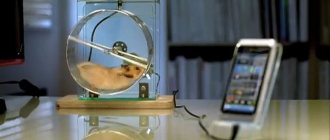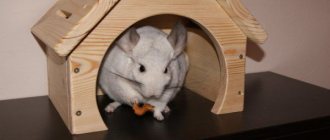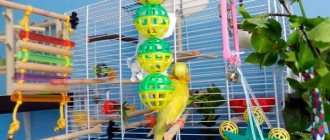Why does a hamster love running on a wheel?
Hamsters have an instinct for survival, that is, searching for food and protecting themselves from predatory animals and birds. You've probably noticed that as soon as you let him walk around the house, the first thing he does is examine the corners and places behind the furniture.
Therefore, nature rewarded rodents with increased activity. A wheel in a cage will help to expend the energy generated in the body as soon as it becomes necessary. The speed of movement of hamsters is approximately 5 km/h, which is the same as when a person walks on foot. The hamster's endurance is also surprising.
He can run 12 km in 10-12 hours.
Peculiarities
The Syrian hamster is one of the most common representatives among rodents, which is usually kept at home. The animal has certain characteristics that should be discussed in more detail.
First of all, veterinarians and biologists highlight such an unusual characteristic of the Syrian hamster as a changed number of toes: there are 4 on the front legs, and 5 on the hind legs
In addition, it is important to note that rodents of this species often have aesthetically pleasing fur, which is traditionally colored golden. Hamsters can also be beige, black, brown, etc.
d. Moreover, the color can be either uniform (consisting of one color) or include several tones and halftones at once.
Among other things, another unusual characteristic of the Syrian breed of rodents is the length of their coat. Thus, short-haired, long-haired and even smooth-haired individuals are distinguished. Moreover, females have much shorter fur than males.
The birthplace of this animal is considered to be Syria (where the name of the breed comes from). Later, the hamster was brought to Great Britain, and from there it spread throughout the world, including our country.
If we talk about the biological characteristics of a rodent, it is important to note that its body length usually does not exceed 12 centimeters in the wild and 20 centimeters at home. Weight varies depending on the sex of the rodent: females can weigh up to 140 grams, and the weight of males, in turn, usually does not exceed 125 grams
However, there are exceptions, the weight of which reaches 200 grams.
What materials are best to make it from?
You can make a wheel from many available materials:
- Tree. Wooden wheels are made from small boards. Ice cream sticks are perfect for this purpose. You will also need a rectangular wooden beam and metal wire. Such a wheel turns out to be durable and requires virtually no financial costs. But if it is not weighted down from below, then it can turn over while running, since it weighs very little.
- Tin can or disk. To make it you will need a tin can of the required size, a screwdriver, a knife for cutting metal, a glue gun, and wire. The design is also quite durable. But if the edges of the jar are not treated, the hamster may cut himself on them. In addition, this design does not look very aesthetically pleasing.
- Cardboard. This wheel is suitable for small rodents, as it is not durable. The design is very simple to make; even a child can do it under the supervision of an adult. Be sure to choose a thick cardboard so that it does not sag under the weight of the hamster.
Have you decided to make a wheel from natural materials?
Is it possible to make them yourself?
You can make tunnels and labyrinths yourself. The simplest, one might say, budget option for such a hole is a construction made of cardboard. Of course, it cannot be used constantly; sooner or later, it will have to be renewed or replaced altogether. Due to the availability of the material, this is actually not critical.
In addition, making a cardboard tunnel with your own hands is a wonderful joint activity for adults and small family members. There are no limits to children's imagination; adults only need to correct their work, imperceptibly correct it and direct it towards creating a cozy mink that is truly acceptable for pets. Children eagerly decorate the building
It is important to ensure that you do not use decorations that are dangerous for rodents, such as rhinestones, and you will also have to exclude some adhesives
The main advantage of such a homemade labyrinth will be its uniqueness. With some experience, you can create replaceable modules that can be periodically replaced or rearranged; this will eliminate habituation, and the pet will constantly explore the proposed structure, which will bring him great pleasure.
The material for creating the labyrinth will be boxes made of thick cardboard, for example, shoe boxes. The set of necessary tools is not so wide: scissors, ruler, compass, pencil, glue or tape.
The largest box can become the basis of a labyrinth. You can draw a plan on its inner surface. The side walls will become its walls. Various kinds of partitions are made from the material of smaller boxes; passages in the form of round holes need to be arranged in them at different but accessible levels for the animal. Inside individual “rooms” various ladders, cubes, and dead-end chambers can be arranged.
The boxes can be combined with tubes, such as toilet paper rolls. Thus, a structure with various passages and chambers can be created in which the pet can spend several hours a day.
Craftsmen build tunnels and labyrinths even from plastic bottles. However, this material has a significant drawback - it is very slippery. Rodent claws cannot cling to a plastic surface, so it is better to combine bottles with a cardboard or plywood base. Bottles can be cut in half and mounted on a rougher surface. If a multi-level hole is not intended, the bottles can be securely connected using tape. One of the undeniable advantages of such a labyrinth is transparency.
PVC plumbing pipes offer the widest scope for imagination and at the same time reliable execution; a wide variety of connections will allow you to create masterpiece structures. It is necessary to make small holes in the walls of such tunnels for ventilation. The tightness of their connections can cause discomfort for rodents.
The basic rules for creating artificial labyrinths are quite simple, there are not many of them.
- Moderation. Overloading the elements of the labyrinth will quickly tire the explorer and he will lose interest.
- Safety. The use of toxic adhesives is unacceptable. The hamster will definitely try out the labyrinth design. It is also advisable to protect it from contact with tape.
- Availability for observation. The animal, while in the maze, should not disappear from the owner’s field of vision. All its movements must be observable, and the owner must always imagine where the pet is currently located. Some hamsters are prone to escape, it can be difficult to get them back, and in the process of being “AWOL” they are exposed to serious dangers.
To learn how to make a tunnel for a hamster from plastic bottles, see below.
What you need to do it yourself
To make a homemade wheel you will need:
- wooden board as a base;
- stick as an axis;
- compass;
- sandpaper;
- ruler;
- hacksaw;
- stationery knife;
- pencil;
- scissors;
- perforator;
- materials for the wheel body (wooden sticks, cardboard, metal or plastic container, wire).
Important! Small children cannot use cutting objects on their own, so you need to call your parents for help.
From plastic bottles
It’s worth saying right away that building a maze for a hamster from plastic bottles is more difficult than from a construction set - here a child cannot do without the help of an adult.
To work, you will need a sharp utility knife and plastic bottles. Their number can be either half a dozen or fifty. The more bottles, the longer and more interesting the labyrinth you can build.
If a hamster can be released into the labyrinths described above only under the supervision of the owner, then he can spend whole days in the bottle labyrinth. Perhaps he will be no less comfortable here than in his usual cage. And there will be much more space for physical exercise. True, a large labyrinth will take up quite a lot of space - also take this into account when starting work.
Having a sufficient amount of material, you can begin construction:
- Take two bottles. In one of them, on opposite walls, make two holes - a large one and a small one. One should correspond to the diameter of the bottle neck, and the second should correspond to the diameter of the bottle.
- Also make a hole near the neck of the second bottle so that the hamster can easily crawl through. Carefully process the edges - there should be no burrs or sharp surfaces here so that the rodent does not get injured during play.
- From the second bottle, unscrew the cap and insert the neck through the large hole, and then through the small one.
- Replace the cap of the second bottle.
Now you have a short maze consisting of two bottles. A hamster placed in one of them will be able to freely make its way into the second; all that remains is to lengthen the labyrinth to the size that seems optimal to you.
When making a labyrinth from plastic bottles, do not forget to make at least several holes in each bottle - it is best to use a thick awl or a hot nail here. Thanks to these holes, the air will be renewed, and your hamster will definitely not suffocate during his morning run.
You can create several spacious areas in the maze using five-liter water bottles. Place a small wheel in one, equip a drinking bowl and feeder in another, a house in the third, and so on. As a result, you will get not just a homemade maze for your hamster, but a full-fledged house with a treadmill.
Step-by-step instructions: how to make a hamster wheel with your own hands at home
Before starting the manufacturing process, you need to study the structural features of a hamster wheel, decide on the size and other characteristics. This will help you make the perfect wheel that your rodent will definitely love.
Running wheel diameter
The most important thing is to choose the right wheel size so that your hamster can run comfortably in it:
- a diameter of 12 cm is suitable for a young hamster;
- for an adult rodent 16-18 cm;
- jungarika – 10 cm.
Important! As your pet grows up, he will need to change the wheel to a larger version.
Surface of the running wheel
The hamster should be comfortable running in the simulator. Therefore, the inner surface must be made ribbed. The rodent will be able to grab onto it with its paws and rotate the cylinder. Corrugated cardboard works well for these purposes. If you are making a wheel from plastic or metal, you will need to cover the inner surface with fabric.
Made of wood
You can make a wooden wheel according to the following instructions:
- Take a thin board and draw 2 circles with the selected diameter.
- Cut out one of them whole, and inside the second, draw a circle with a diameter less than 1 cm and cut it out too.
- On a solid circle, make a hole in the center and several more small holes around it.
- Take the popsicle sticks and cut them so that they are 5-6 cm long.
- Connect both parts using sticks and a hot gun, creating a wall for the rodent to run along.
- Using a nut and screw, screw the wheel to the wall of the cage.
From a hard drive and a jar
You can make a hamster wheel from a can in half an hour using improvised means:
- Select a container of the required diameter.
- Measure 5-6 cm from the bottom along the wall and cut off the excess.
- Sand the edges and interior surface with sandpaper.
- Take a cocktail tube and connect 2 points of the circle with it so that it runs through the center.
- Glue the edges with tape or a glue gun.
- Make holes in the center of the bottom of the jar and in the middle of the straw.
- Stick a wooden skewer into them.
- Check that the wheel rotates freely along the axle.
From cardboard
It’s as easy as shelling pears to make a wheel out of cardboard paper:
- Draw on cardboard and cut out blanks for the future wheel with a stationery knife: two circles of the same size with holes for the rodent, 2 parts in the shape of the letter “P” for attaching the wheel, a strip 5-6 cm wide and equal to the length of the circle.
- Bend the strip, connecting its edges, and glue it between the circles.
- Take a knitting needle and thread it through the centers of the circles.
- Attach the sides.
- Bend the ends of the knitting needles so that the circle does not fly off.
Nuances in making a running wheel
When working on the simulator, the following points must be taken into account:
- the wheel must rotate freely around its axis;
- it must be stable and not lose balance when a hamster gets into it;
- Don't forget to trim the edges so your pet doesn't get hurt.
Important! Remains of glue must be removed from the surface so that the rodent does not accidentally swallow it.
General requirements for the accessory
When purchasing a treadmill or designing it yourself, you must take into account the mandatory requirements that will allow your animal to use it without much effort.
Such requirements include:
- suitable design dimensions, which are the basis for choosing an accessory, for example, 18-centimeter diameter simulators are suitable for Syrian hamsters, and 16-centimeter ones are suitable for dwarf hamsters or baby Syrian hamsters;
Important! If you still decide to purchase an exercise machine on a stand, choose an accessory that will have a free space between the wheel and the stand of more than 1 cm. - safety of attaching the accessory, which will allow you to securely attach the exercise machine to the cage: it can be attached between the bars - this is an ideal option, but you should avoid structures that are attached to stands that are closely adjacent to the working surface of the accessory, which often leads to injuries to hamsters due to getting their paws in the space between the wheel and the stand;
- a safe working surface of the structure, that is, the part on which the hamster runs (the best option is a surface made of plastic and having special notches that prevent the animal’s paws from sliding on the surface);
You should not purchase exercise machines that have a mesh running surface, since the animal’s paws can get caught in the mesh cells and the animal will be injured; Did you know? Hamsters live very short lives, about 3 years. Each year a rodent lives is equivalent to 25 human years. Dwarf representatives can live the longest - 4 years. - quiet operation is also an important factor, since hamsters prefer to run at night, and if the cage with the animal is installed in a living room where people spend the night, this may cause discomfort from the noise of the simulator generated during the hamster’s running;
- the ease of rotation of the wheel should also be taken into account so that the animal can easily move on the surface, otherwise the animal may simply refuse to use the accessory.
Types of simulator and mounts
Running wheels differ in their inner surface. It can be solid, lattice or mesh. It is safest to choose wheels without holes so that the hamster's paw cannot fall into it.
Wheels also differ in the type of fastening:
- to the cell wall. Saves space in the hamster's home, but when used it knocks on the rods or board.
- To the bottom of the cage. Such exercise machines are unstable and can tip over if the rodent starts to run.
- On a stand. The best option for hamsters if space in the cage is not limited. Very stable and causes minimal noise.
Cardboard
This type of simulator is very inexpensive, but not durable . In addition, the hamster can chew on it significantly during a break between runs. Anyone can make such a wheel, even without special skills.
This is a great option for hamsters who are just starting to run or as a temporary trainer until you get a more durable one.
Silent
Many people choose this type of exercise machine because hamsters love to run at night. The noise from the rotation of the wheel can be heard all night and interfere with sleep.
Thanks to the special design, the parts do not touch each other and do not create extraneous sounds. But it is worth noting that such wheels are much more expensive than regular ones.
Wood
A wooden treadmill keeps the environment around the rodent environmentally friendly. This is a big plus for his health. These wheels are a little more expensive than regular ones, but you can make them yourself.
Features of the structure of the running wheel
Any running wheel consists of a cylinder, which is mounted on an axle. When choosing a simulator, it is important to ensure that it rotates evenly and does not deviate to the sides. The wheel stand must be stable. Otherwise it will turn over.
Important! The design of the wheel should not contain foreign objects, for example, to decorate the simulator. They will interfere with the hamster's running and may cause injury.
Why do you need a trainer?
Hamsters, by nature, are nocturnal rodents.
Under natural conditions, animals run long distances in order to feed themselves. Hamsters kept at home are deprived of this opportunity. In addition, there is simply no particular need to independently search for and obtain food, since timely and sufficient feeding of the pet is provided by its owner. But despite favorable conditions and satiety, hamsters still need to periodically receive physical activity. This is necessary not only to entertain the animal, but also to maintain the health of its cardiovascular system. Regular physical activity stimulates the rodent's metabolism and metabolism, helping to keep the muscular system in good shape.
And in a small cage, you need to give the hamster the opportunity to move, because it is not safe to let him roam freely. Due to its small size, the animal is not very visible and can be accidentally injured. But other pets can also be dangerous for hamsters: cats, dogs, large parrots.
A convenient and safe solution to this problem is to install a running wheel directly in your pet’s home. Hamsters quickly understand how to use it, and if they want, they can climb onto the simulator and run around at any time.
The only drawback is that the hamster is a nocturnal animal. That is, its activity in most cases occurs at the time of day when we are used to sleeping. Therefore, active night runs can disturb apartment dwellers if the wheel squeaks or makes a knocking sound.
Disadvantages of purchased hamster wheels
The main disadvantage of purchased wheels is their cost. A medium-sized exercise machine will cost no less than 700-1000 rubles. Plastic wheels may contain harmful impurities that will worsen the hamster's health.
Often, purchased hamster wheels are coated with paint that a rodent can tear off with its teeth. If it gets into the animal's stomach, it can cause intoxication. Therefore, things made with your own hands are sometimes safer for your beloved pets.
How to make a silent attraction yourself?
Since the hamster is a nocturnal animal, the peak of energy occurs in the dark, when the owners are already sleeping peacefully. At this moment, the fluffy is running in a wheel, creating a rumbling noise that can disturb an insensitive sleep.
Therefore, many rodent owners are wondering how to make a silent hamster wheel with their own hands. Let's figure it out together.
Let's prepare a round plastic tray or box for storing discs. You will also need a dowel with a curved screw and an awl. Then everything is elementary. We make a hole in the center of the base into which the smooth end of the screw will fit. Using an awl, we make through punctures in the running area so that the fluffy’s paws do not slip. We insert a curved screw into the dowel from the outside between the rods so that the fastener rests against the cage, and from the inside of the hamster’s apartment we put a plastic blank on the metal part.
How to train a rodent to run
Some hamsters don't understand why they need a wheel until they try to run in it. Others become lazy over time and don't want to move much. Experts recommend using the following tricks:
- Lure with a treat. You won't give your hamster a choice if you put food directly into the drum. You need to do this for several days in a row until the rodent itself begins to come and climb into the wheel.
- Blocking the exit. Take a piece of cardboard or a piece of wood and cover the entrance to the wheel with it when the hamster gets into it. He will only have to move in one direction, causing the wheel to rotate.
Training a hamster to use a running wheel
If this is your pet hamster's first time spinning the wheel, you will need to help him use the wheel correctly. You can place your pet's favorite food in the drum and repeat this process several times. The treat should always be placed at different levels so that the animal tries to get to it and understands the principle of the drum’s operation. Another training method is to close the exits from the wheel, which will force the animal to move around the simulator in order to get out of it.
After a short period of time, your pet will definitely get used to it and will spend time with great pleasure on its new favorite exercise machine, which you made with your own hands.
Possible problems
Even using such a simple design can cause difficulties. Most often, hamsters refuse to run in a wheel. It also happens that over time the wheel begins to squeak.
The wheel squeaks
The structure may creak as a result of prolonged use. The parts deform over time and come into contact with each other during rotation. The solution is to lubricate the surfaces with oil. If a new wheel squeaks a lot, it may be defective.
Hamster doesn't run on a wheel
This problem can occur for several reasons:
- The rodent doesn't like the wheel. Try replacing it with a machine made of a different material or with a different design.
- The hamster has a hard time turning the wheel. This may happen due to the age of the animal. Rodents older than 2-3 years are considered old and they lose the desire to move a lot.
- The hamster has an injury. It may also happen that the rodent injured its paw or hit itself. Find out by watching him. If he used to be cheerful and active, but suddenly suddenly stopped running and playing, you should take him to the vet.
Manufacturing
Before you start making an attraction for your pet, you should at least understand in general terms what a jogging wheel should look like.
- The attraction must be of suitable size. The animal should not be cramped inside, otherwise it will not be able to move comfortably. Excessively large dimensions of the running structure are also undesirable. It will be very difficult for a hamster to spin such a wheel with its paws. For an adult Djungarian hamster, a diameter of 14-16 cm is suitable. For animals of the Syrian breed, it is better to make the attraction larger, since they are larger. For an adult, the diameter of the circle should be at least 20 cm.
- The width of the treadmill also matters. If it is not wide enough, the hamster will periodically fall and may get injured. For small and medium-sized individuals, it is better to make a simulator 5 cm wide. For larger breeds, a track width of 7-8 cm is recommended.
- The running wheel should spin easily. Otherwise, the animal will quickly get tired and may lose interest in its attraction.
- It is worth taking care that the pet does not injure its paws during exercise. This directly depends on the material and structure of the treadmill surface. If you decide to use mesh materials, then make sure that the cells are as small as possible. Otherwise, the hamster's paw may get stuck in them while running. And also, the simulator should not have sharp jagged edges or bumps that the hamster could trip over.
- The treadmill inside the wheel should not be slippery. Therefore, a smooth plastic surface should be covered with thick cloth in advance. The pet will be able to cling to it with its claws.
- When installing the wheel, you should ensure that it is securely fastened. The animal moves quite intensely on the track, and the shaky structure can topple while it runs. Therefore, the treadmill must be attached to the bars of the cage or placed on a strong and stable support.
From plastic bottles
Required materials: a large round plastic bottle, a nail, a dowel with a diameter of 1 cm, a strip of thick fabric.
Step-by-step instruction:
- measure 7-8 cm from the bottom of the bottle and cut it at this level;
- Make a hole in the center of the bottom of the cut container and insert the head of the prepared nail into it;
- insert the nail into the dowel;
- Cover the slippery surface of the bottle with a thick cloth;
- Attach the homemade wheel to the cage bars using a dowel.
A simple cardboard option
To make it, you need to prepare a strong knitting needle, a sheet of thick cardboard, glue, a ruler, and scissors.
The work progress includes several steps.
- Using a compass, draw two identical circles on cardboard and cut them out. They will serve as walls on both sides of the path.
- Make 2-3 square or round windows on the circles with scissors. Their dimensions should be slightly larger than the size of your pet. Through these holes the hamster will be able to get inside his running wheel.
- From the remaining cardboard, cut out a long strip 5-7 cm wide. This will be the attraction track.
- Glue a strip of cardboard between the two circles. Let the glue dry and hold the parts together well.
- Determine the center of the circle and pierce both walls with a knitting needle in this place.
- The resulting wheel can be placed on a support or attached to the wall of a house or cage using flexible wire.
From a tin container
To make a simulator you will need: a cylinder from a computer system disk (hard drive), a tin can of the required diameter, glue for metal, flexible wire, a file, a piece of fabric material.
Making a running ride:
- the first thing to do is to remove the metal cylinder from the faulty hard drive; to do this, open the disk cover and carefully remove the part;
- Cut the tin container at a distance of 6-7 cm from the bottom, file the edges.
- cut a strip of fabric along the width and length of the treadmill and cover the inside surface of the tin container with it;
- to make the design as silent as possible, you can glue a circle of fabric to the bottom of the jar;
- take a metal cylinder from a hard drive and glue it exactly in the center of the round wall of the wheel;
- Once the parts are firmly connected, the running wheel can be secured to the bars of the cage.
Watch a video on how to make a hamster wheel with your own hands below.
https://youtube.com/watch?v=b_nohA6tcUc
Tools and materials for creating a wheel
DIY dog harness: step-by-step instructions
Crafts for hamsters are made from a variety of materials using simple tools:
- wide round plastic bottle;
- scissors;
- nails;
- thick fabric;
- plywood;
- dowel with a diameter of 1 cm;
- cylinder from a computer disk (hard drive);
- metal cutting scissors or file;
- universal glue for metal;
- wire;
- bamboo wallpaper;
- swing bearing;
- drill;
- jigsaw;
- hammer;
- compass, ruler and pencil.
These tools and materials will help you create a structure with suitable parameters and securely fasten it.
Tools and materials for work
What types of homemade wheels are there?
It is a mistake to start building an attraction right away. First, you should understand the types of wheels and what criteria are important for choosing a toy for an animal.
First of all, we pay attention to the diameter of the simulator. It depends on the length of the pet itself. For the Syrian fluffy, the diameter of such equipment varies from 12 to 18 cm, and for the Dzhungarik - from 10 cm . If the animal is dwarf or is still in the process of growing, then a wheel with a smaller diameter will do. When your pet grows up, it is important to replace the attraction with a suitable one.
Why does a hamster chew on its cage?
The wheels also differ in the method of fastening. There are only 2 types:
- Those that are installed on a stand.
- Those that are attached to the bars of the cage.
The last option is considered to be the most safe and reliable. A wheel on a stand can cause harm to a fluffy cat if the necessary distance between the parts is neglected.
Silent wheel with bearing
Almost all owners who tried to make a hamster wheel on their own experienced unpleasant consequences. The wheels attached to the axle are very noisy while driving. Even purchased accessories become loose over time and begin to creak and make noise.
The silent bearing wheel is an excellent and very durable alternative. Using a bearing, you can make a hamster wheel from scratch or remake a purchased accessory that has begun to make noise while moving.
Bearing from roller skates or scooter
To make or upgrade a hamster wheel, you can use a roller or scooter bearing. Before use, it is important to ensure that the bearing is in good condition. If the bearing has already been used, it needs to be cleaned or washed. Afterwards, you need to rotate the bearing in absolute silence. If you hear squeaking, whistling or other extraneous sounds, this bearing will not fit.
The bearing is of a suitable size, must be pre-lubricated and secured to the rear wall of the wheel. Before gluing the bearing to the back wall, it must be equipped with wire ears, since such an accessory can only be suspended.
Bearing from an old hard drive or DVD/CD
One of the most interesting and at the same time time-consuming ways to make a hamster wheel. If you want your pet to be able to play with the wheel at any time without disturbing the household, you will need a bearing from an old hard drive or DVD/CD.
The method is a little unexpected, but now we will figure it out in order. So, you will need:
- Old style hard drive.
- A small Phillips screwdriver to remove the hard drive cover.
- A large round container from which the wheel itself will be made.
- Scissors or a knife, depending on the material from which the container is made.
- Glue gun.
Wheel made from a plastic bottle
Many owners think that the best manufacturing option is a wheel made from a plastic bottle. In fact, it all depends on the size of the hamster. If we are talking about a baby that exhibits a high degree of activity, a cut-off plastic bottle can actually be used as a temporary wheel. For an adult animal, such an accessory is not suitable, since the rodent will have to take an unnatural position while running.
Most likely, after spending several hours of time, you will be disappointed, because the hamster will run in the wheel 1-2 times and lose interest.
Alternatively, you can use 3-5 liter plastic containers. In this case, the problem with the size of the wheel is solved, but a new one appears - by cutting the plastic container to the required height, you will deprive it of its rigidity and the wheel will turn out to be unstable.










